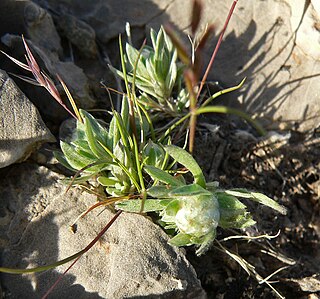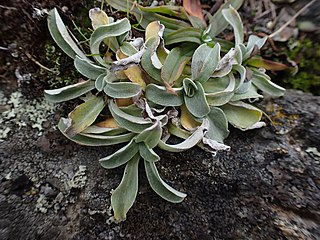
Vaccinium is a common and widespread genus of shrubs or dwarf shrubs in the heath family (Ericaceae). The fruits of many species are eaten by humans and some are of commercial importance, including the cranberry, blueberry, bilberry (whortleberry), lingonberry (cowberry), and huckleberry. Like many other ericaceous plants, they are generally restricted to acidic soils.

Helianthella, the little sunflower, is a genus of North American plants in the sunflower family.

Rigiopappus is a genus of North American plants in the aster tribe within the sunflower family. It is closely related to genus Pentachaeta.

Lepidospartum is a genus of North American desert shrubs in the daisy family. They are known commonly as broomsages or scalebrooms. These are tall, woody shrubs with stiff twiggy branches that resemble brooms. They are native to the southwestern United States and far northern Mexico. These shrub have thin, narrow, needlelike or scalelike leaves and bear yellow daisy flowers.
Hesperevax caulescens is a small flowering plant in the daisy family. One common name for the plant is hogwallow starfish, as it is a somewhat flat, star-shaped plant which grows in mud. Another common name is dwarf dwarf-cudweed, as the three members of genus Hesperevax are known as dwarf-cudweeds and this species is smaller than the others. It may also be called involucrate evax, since its former Latin name was Evax involucrata. This annual plant is a member of the vernal pool plant community in California, where it is possibly an endemic species, although its range might extend into Baja California. The hogwallow starfish radiates pale green spoon-shaped leaves in a basal rosette and extends a short erect stem. The flowers are less than two millimeters wide. This species grows along the outskirts of vernal pools in areas which have dried.

Hulsea is a small genus of North American flowering plants in the sunflower family known commonly as alpinegold.

Stylocline(neststraw) is a small genus of North American desert plants in the Inuleae tribe within the daisy family.

Ancistrocarphus is a genus of flowering plants in the aster family. It contains two known species, both native to western North America. These plants are often treated as members of genus Stylocline, but they are not as closely related to Stylocline species as they are to plants of other genera, especially Hesperevax.

Hesperevax sparsiflora is a species of flowering plant in the daisy family known by the common name erect dwarf cudweed. It is native to California and Oregon, where it grows in several habitat types including sandy coastal areas and the serpentine soils of inland hills. This is a small woolly annual herb reaching maximum heights under 18 centimeters. It has oval to rounded or scoop-shaped leaves on short petioles which vary in morphology across varieties. Small flower heads appear between the leaves. They contain greenish or whitish disc florets.

Logfia is a genus of herbaceous plants in the cudweed tribe of the sunflower family, known as the field cottonrose.
Hesperevax acaulis is a species of flowering plant in the aster family known by the common name stemless dwarf cudweed. It is native to California and Oregon where it grows in many types of mountain, valley, and coastal habitats, including areas recently affected by wildfire. This petite woolly annual forms a small bunch on the ground. Despite its common name it sometimes has a stem a few centimeters long. The wool-coated leaves appear in pairs or clusters, each leaf measuring a few millimeters to three centimeters long. In the center of the leaf array is the inflorescence, which is a single flower head or tightly packed cluster of several heads, each just a few millimeters wide. The flower head contains several tiny disc florets.
Diaperia is a genus of flowering plants in the daisy family, formerly considered part of Evax. Common names include "rabbit's tobacco" and "dwarf cudweed." These are annual herbs native to the northern Mexico and the central and southern United States, primarily the Great Plains.

Psilocarphus is a genus of flowering plants in the pussy's-toes tribe within the daisy family.

Gamochaeta is a genus of flowering plants in the aster family. There has not always been agreement among botanists regarding its status as a recognized genus, but it has become more accepted in recent years. It currently includes many plants that previously belonged in genus Gnaphalium. Like many species of Gnaphalium, many Gamochaeta are called cudweeds or everlastings.

Hemizonella is a genus of North American plants in the tarweed tribe within the sunflower family.
Diaperia candida, common names silver pygmycudweed and silver rabbit-tobacco, is a plant species in the sunflower family, native to the south-central part of the United States: Texas, western Louisiana, southwestern Arkansas, southeastern Oklahoma.
Gamochaeta stagnalis, the Desert cudweed, is a species of flowering plant in the sunflower family. It is native to Mexico, Guatemala, and the southwestern United States.

Gamochaeta ustulata, commonly named featherweed or Pacific cudweed, is a North American species of flowering plant in the sunflower family. It is native to the western United States and southwestern Canada, in British Columbia, Washington, Oregon, and California. It is found primarily on seaside hills and in the Coast Ranges, with additional populations inland.
Symphoricarpos acutus, the sharpleaf snowberry, is a North American species of trailing shrubs in the honeysuckle family. It is native to the western United States.













